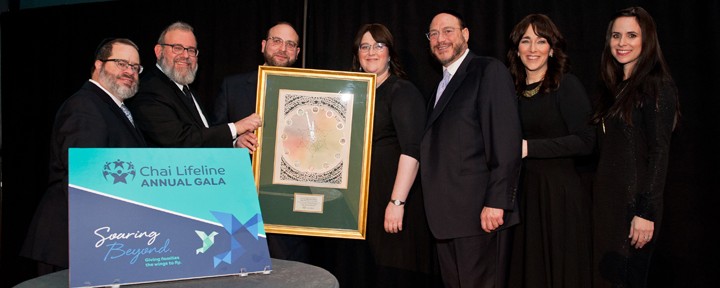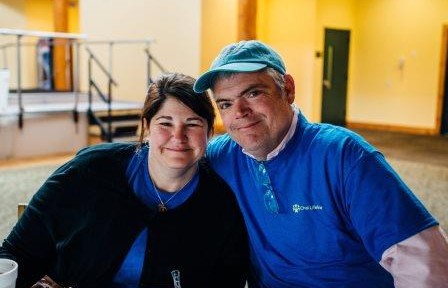 More than 1,300 friends and supporters of Chai Lifeline crowded into the Marriott Marquis’ Grand Ballroom earlier this month to be inspired by the organization’s work and those who make it possible. read full story
More than 1,300 friends and supporters of Chai Lifeline crowded into the Marriott Marquis’ Grand Ballroom earlier this month to be inspired by the organization’s work and those who make it possible. read full story


 More than 1,300 friends and supporters of Chai Lifeline crowded into the Marriott Marquis’ Grand Ballroom earlier this month to be inspired by the organization’s work and those who make it possible. read full story
More than 1,300 friends and supporters of Chai Lifeline crowded into the Marriott Marquis’ Grand Ballroom earlier this month to be inspired by the organization’s work and those who make it possible. read full story

 The story of Chanukah is a tale of how a small number of people can change the lives of a geometrically expanding group. And in many ways, that is also the story of Chai Lifeline’s Chanukah programs: within a few weeks, they have impacted the lives of 10,000 children and their families around the world, bringing light to lives that have been darkened by the presence of illness, loss, or trauma. read full story
The story of Chanukah is a tale of how a small number of people can change the lives of a geometrically expanding group. And in many ways, that is also the story of Chai Lifeline’s Chanukah programs: within a few weeks, they have impacted the lives of 10,000 children and their families around the world, bringing light to lives that have been darkened by the presence of illness, loss, or trauma. read full story

From the moment you wake up until the time you rest your head upon your pillow at night, your day is filled with the responsibilities of caring for your sick kid (or sick children!), and their brothers and sisters. Treatment, therapy, medical appointments, or school issues, not to mention the day to day necessities of taking care of a home and making a living. As you haul that last load of laundry up the stairs or fall into bed at night, you find yourself wondering, “When is it time for ME?”
read full story

Adolescence is a time when parents of teens with chronic illnesses or medical challenges may want to tear their hair out.
Adolescence is the period where teens need to psychologically move away from their parents and become more independent. Many times, teens will push limits to see how far they can go.
read full story

When a child is born or diagnosed with a serious illness, brothers and sisters are bound to be impacted. Why do some exhibit signs of stress or depression while others seem to thrive?
Siblings living alongside a child with a chronic illness will experience a jumble of positive and negative reactions. They can feel love and a combination of resentment, embarrassment, guilt, sorrow or fear simultaneously. Without the skills to understand and cope, a child’s self-esteem can suffer. Anger and guilt can turn inward, leading to a sense of shame or worthlessness. Depression, anxiety or somatic symptoms can arise.
read full story

Despite having lost both his legs to illness, Benji maintains there are no limits to what he will accomplish in life.
Too often, our default emotion when we hear about childhood illness is pity. It’s natural to feel awful when confronted with the reality of pediatric illness, but does it really reflect how children with illnesses see themselves?
read full story
We welcome this contribution from Deanna Power of Social Security Disability Help. Please note that we cannot answer any questions about specific situations. Please address all questions about eligibility or how to apply to help@disability-benefits-help.org.
It is almost a law of nature that a child’s illness impacts a family’s income. Medical bills, time off from work, extra housekeeping or childcare needs add up quickly. SSI (Supplemental Security Income), a program administered by the Social Security Administration (SSA) provides some relief for families through monthly financial assistance to parents of children with life-threatening or severe chronic illnesses.
read full story

The right camp experience is the one that offers children fun, friendship, and a chance to enhance their social and emotional toolbox.
Clearly, this is the most important concern regardless of a child’s health status. Parents should ascertain that the camp’s facilities are appropriate. If the child needs a wheelchair or walker, there should be easy access to every building so that the child can participate in all aspects of camp life. As important, maintenance and cleanliness standards must be high. Parents should also check the medical program: is there staff who can deal with both day-to-day needs and emergencies? Does the camp have emergency procedures in place? What about medication? Injections? Does the camp feel confident that its medical staff can deal with your child’s health requirements? Do you?
air jordan Inexpensive
What about your child’s social and emotional needs?
Summer camp is about friends and fun, but it’s also about growth and self-enhancement. The best camp for your child is the one that will allow him or her to shine through friendships and new skills. When the choice is between a “normal” camp and one designed for children with special needs, parents should consider the child’s social life throughout the year. Children who have to work to keep up may do better in a camp where everyone is working at their pace.
Oakley sunglasses Clearance
“Sometimes children with illnesses or disabilities are the only kids who are sick in school. They are labeled. They feel left out. They may have few friends. These children may do better in an environment of peers, where all the children are struggling with similar challenges,” said Mrs. Reichmann. “They learn to appreciate their own strengths and differences. They are no longer isolated. The ‘bump’ they get at camp may be enough to make a difference all year long.”
Note: The professionals at Project CHAI, Chai Lifeline’s crisis intervention and bereavement division are available to answer questions and provide personalized assistance to parents, educators, and community leaders following this weekend’s tragic fire in Midwood, Brooklyn. Please call 855-3-CRISIS or email CRISIS@CHAILIFELINE.ORG. Rabbi Sruli Fried, MSW, has prepared this video presentation: Speaking To Your Children About the Midwood Fire
The Jewish community of Midwood, Brooklyn, one of New York’s five boroughs and home to one of the largest Jewish communities outside Israel, was rocked by the devastating fire that killed seven siblings, ages 5 to 16, and left a mother and surviving daughter in critical condition.
Within minutes after the Sabbath ended, Chai Lifeline’s crisis hotline lit up with phone calls from concerned parents who needed assistance talking to their children about the tragedy. Project CHAI’S professionals, all therapists with training and experience in responding to traumatic situations, offer the following suggestions for parents, educators, and community leaders:
white ray ban sunglasses
Physicians Lisa Diller, the chief medical officer of the Dana-Farber/Boston Children’s Cancer and Blood Disorders Center and Peter Manley, an oncologist and director, Stop & Shop Family Pediatric Neuro-Oncology Outcomes Clinic, note five areas for pediatricians as survivors transition back to healthy pediatric care.
ray ban sunglasses Spain

nike air max USA
1. Physicians should receive a copy of the child’s treatment summary and care plan created by the oncologist.
Discount Oakley sunglasses
2. Remember that the end of treatment is also a time of anxiety and transition for children and parents.
3. Watch for signs of side effects from treatment. (The article notes resources for the physical effects of treatment, but pediatricians and parents should be on the lookout for emotional and social changes as well.)
air jordan website
4. Know what services are available for survivors and their families.
5. Promote good health habits.
Read the entire article here.